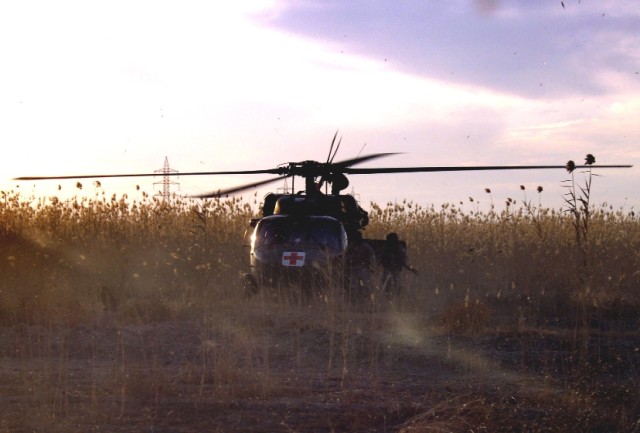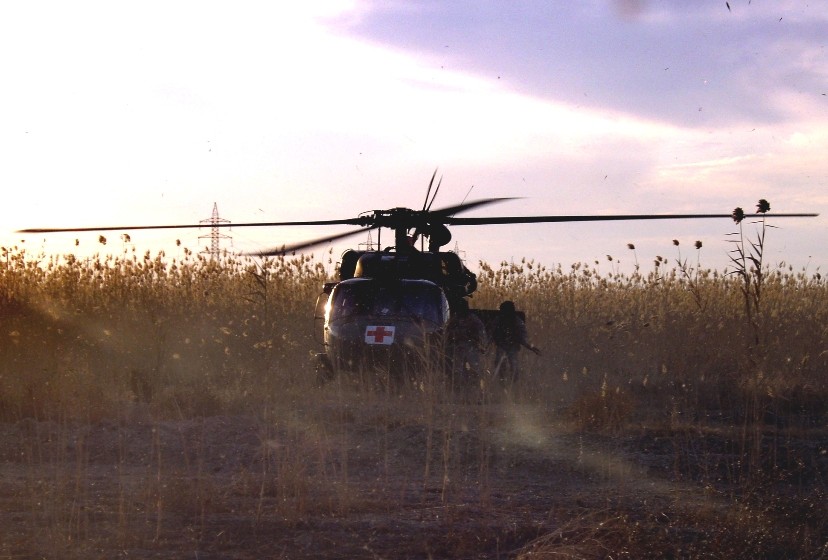CAMP STRIKER, Iraq (Army News Service, Jan. 22, 2007) - Aero-medical evacuation crews from Task Force Marne faced enemy gunfire to deliver five injured Soldiers to safety Jan. 18.
MEDEVAC crews from Company C, 2nd Battalion, 3rd Aviation Regiment, Combat Aviation Brigade, 3rd Infantry Division, were called in when a patrol of Strykers from the 2nd Brigade Combat Team, 25th Infantry Division was attacked.
The two Black Hawks arrived to find the best landing site, the road the Stryker vehicles were on, had not been cleared of possible improvised explosive devices. After circling, the crews landed in a field adjacent to the road, said Capt. Samuel Fricks, operations officer and a pilot in the second aircraft.
"After landing, my medic, Staff Sgt. Robert Congdon, departed the aircraft and linked up with Staff Sgt. Aughe McQuown," he said.
The two medics went to the site of the attack and soon returned to the helicopters with three injured Soldiers, but as they returned to the Stryker for the two remaining injured Soldiers, Congdon said, they began taking fire.
"I just grabbed the patient and grabbed McQuown and we went into the Stryker," he said.
Bullets struck the Stryker and flew around them as they ran for the cover of the armored vehicle. Congdon reset the Stryker's radio to the MEDEVAC frequency and changed into a Stryker-crewmember's helmet so he could talk to the aircraft.
When the call came over the radio that his medics were taking fire, Fricks didn't know what to think. He didn't know where the fire was coming from, but he figured that since the helicopters were in the field, below the level of the road, the crews and rescued Soldiers weren't in too much danger.
"The only thing we knew was that Staff Sgt. Congdon was taking fire," he said.
Fricks radioed circling Apache helicopters and relayed Congdon's directions to bring in 30 mm machine-cannon fire to suppress the enemy shooter.
As they waited for the Congdon and McQuown to return, Sgt. Donald Dedmon ran back and forth between the helicopters, treating the injured Soldiers already on board.
Dedmon was only midway through training for certification to be a lone medic on a MEDEVAC when he was suddenly responsible for patients on two different aircraft.
"I was keying on the patients," he said. "Afterward it kind of came into perspective."
Back at the Stryker, Congdon and McQuown were attempting to get back to the aircraft with their patients.
"We lowered the ramp (of the Stryker) to get out and be able to get to the aircraft and (the sniper) started shooting," Congdon said.
McQuown picked up one patient while Congdon and an infantry Soldier helped the other patient and they ran for it.
"It was a combination of, they ran out of litters and the guy was shooting at us," Congdon said. "The longer we wait on the ground, the worse it is on the patient, so at some point we had to just leave and get the patients to the hospital."
The medics loaded the remaining two patients on the MEDEVAC birds. After a quick head count to make sure no one was left behind, they departed while the Apaches continued to lay down suppressive fire.
"The five patients we hauled all survived," Fricks said. He said watching the two medics struggling to bring their patients to safety was almost like something you'd see in a Hollywood production. "I just thought it was awesome."
(Sgt. 1st Class Thomas Mills serves with the 3rd CAB, 3rd Inf. Div. Public Affairs Office.)


Social Sharing